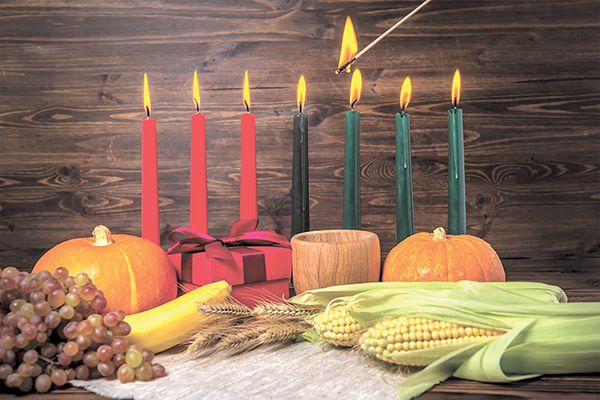
By Allison Perrine
RED BANK – The holiday season means many things to different people, but one common theme is tradition.
That stands for most of the well-known religious holidays, but also for Kwanzaa, observed each year Dec. 26 through Jan. 1 when individuals of African descent celebrate their heritage. Members of the Red Bank Public Library (RBPL) discussed the holiday Dec. 29 as part of the final Let’s Talk About Race program of 2021.
“When we take the time to learn about other people and their lives, their cultures and their histories… we discover a common humanity,” said Sira Williams, head of children’s services at the RBPL. “My hope is that by the end of this program… you will have a new appreciation for Kwanzaa and what a beautiful holiday it is.”
Williams, who celebrates Kwanzaa and Christmas each year, kicked off the conversation by explaining the holiday. The week-long tradition is not “steeped in history” like the other holidays observed at the end of the year; it is merely a few decades old. Established in 1966 by professor Maulana Karenga, the idea arose during a “tumultuous time” in the U.S. amid the Civil Rights Movement, Vietnam War and rising Black Power movement.
“People were beginning to get frustrated with the slow pace of change of the nonviolent movement of Dr. Martin Luther King, and so there was a push for a cultural revolution for Black Americans to return to Africa culturally and spiritually because they couldn’t go back physically,” said Williams. “Kwanzaa was born out of those feelings.”
Dressed in Malian clothing and jewelry to honor the African country she was born in, Williams shared the meaning behind the symbols of Kwanzaa which she had on display for attendees of the virtual Zoom meeting. She started with the mat – “mkaka” in Swahili – which represents community.
“All of the fibers in the mat are interconnected and woven together and, although there are individual fibers, when they are woven together they make a very strong unit,” she said. “It reminds me that our community should be inclusive of everybody, no matter who they are or what they look like.”
Other symbols include a unity cup or “kikombe cha umoja”; corn or “muhindi,” which represents children; fruit or “mazao,” which represents the bounty of the harvest and the things people are thankful for; and a candleholder or a “kinara,” which is central to the celebration.
The kinara features seven candles, three of which are red to represent history; three green to represent the future; and one black to represent Black people.
“As we light the candles, we talk about the principle of the day… and what it means to us and how we can incorporate it more into our daily lives,” said Williams.
There are seven principles of Kwanzaa, the first being “umoja” (unity); “kujichagulia” (self-determination); “ujima” (collect work and responsibility); “ujamaa” (cooperative economics; “nia” (purpose); “kuumba” (creativity); and “imani” (faith).
On the last night of Kwaznaa some families have a feast, a “karamu,” with loved ones and community members when gifts are exchanged. But the gifts are not toys, gift cards or video games – they are gifts that play into the principles of Kwanzaa, Williams said.
“We want our children to know about our history. We might give them books… or in line with the principle of creativity or kuumba, we might give them a craft project or something to do together,” she said.
Williams, whose mother is white, said that she did not grow up celebrating Kwanzaa as a child and hadn’t heard of it until later in life. When her oldest daughter was in second grade and was “one of the few Black kids in her class,” her teacher approached Williams and asked that she come into the classroom and speak with the children about Kwanzaa someday. Even though she knew little about the holiday, she agreed.
“My husband went out and bought a beautiful display, and I read some articles and did some research and found some children’s books. That’s how it all began for us,” she said.
The article originally appeared in the January 6 – 12, 2022 print edition of The Two River Times.














